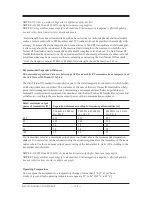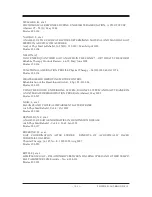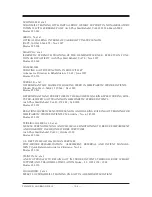
NOTE 1:
UT is the a.c. mains voltage prior to application of the test level.
NOTE 2:
At 80 MHz and 800 MHz, the higher frequency range applies.
NOTE 3:
These guidelines may not apply in all situations. Electromagnetic propagation is affected by absorp-
tion and reflec¬tions from structures, objects and people
a
Field strength from mixed transmitters, such as base stations for radio telephones and land mobile
radios, amateur radio, AM or FM broadcast and TV broadcast cannot be predicted theoretically with
accuracy. To assess the electromagnetic envi¬ronment due to fixed RF transmitters, an electromagnet-
ic site survey should be considered. If the measured field strength in the location in which the Gait
Trainer III Treadmill is used exceeds the applicable RF compliance levels above, the Gait Trainer III
Treadmill should be observed to verify normal operation. If abnormal performance is observed, addi-
tional measures may be necessary, such as re¬orienting or relocating the Gait Trainer III Treadmill .
b
Over the frequency range 150 KHz to 80 MHz, field strengths should be less than 3 V/m.
recommended separation distances
Recommended separation distances between portable and mobile RF communications equipment and
the Gait Trainer III Treadmill. Table 6
The Gait Trainer III Treadmill is intended for use in the electromagnetic environment in which radiat-
ed RF disturbance are controlled. The customer or the user of the Gait Trainer III Treadmill can help
prevent electromagnetic interference by maintaining a minimum distance between portable and
mobile RF communication equipment (transmitters) and the Gait Trainer III Treadmill as recommend-
ed below, ac¬cording to the maximum output power of the communication equipment.
rated maximum output
power of transmitter [w]
separation distance according to frequency of transmitter [m]
150 kHz to 80 MHz
80 MHz to 800 MHz
800 MHz to 2.5 GHz
d = 1.2√ P
d = 1.2√ P
d = 2.3√ P
0.01
0.12
0.12
0.23
0.1
0.38
0.38
0.73
1
1.2
1.2
2.3
10
3.8
3.8
7.3
100
12
12
23
For transmitters rated at a maximum output power not listed above, the recommended separation
distance d in meters (m) can be estimated using the equation applicable to the frequency of the trans-
mitter, where P is the maximum output power rating of the transmitter in watts (W) according to the
transmitter manufacturer.
NOTE 1:
At 80 MHz and 800 MHz, the separation distance for the higher frequency range applies.
NOTE 2:
These guidelines may not apply in all situations. Electromagnetic propagation is affected by absorp-
tion and reflection from structures, objects and people.
operating temperature
Do not expose the equipment to a temperature change of more than 5° F (3° C) per hour.
Limits of low and high operating temperature ranges are 59° to 86° F (15° C to 30° C).
CONTENTS
ELECTROMAGNETIC COMPATIBILITY
— 10-4 —
Summary of Contents for 950-284
Page 21: ......
Page 27: ......
Page 29: ......
Page 40: ...13 1 ASSEMBLY DRAWINGS AND SCHEMATICS 13 ASSEMBLY DRAWINGS AND SCHEMATICS...
Page 41: ...ASSEMBLY DRAWINGS AND SCHEMATICS 13 2 CONTENTS...
Page 42: ...13 3 ASSEMBLY DRAWINGS AND SCHEMATICS CONTENTS...
Page 43: ...ASSEMBLY DRAWINGS AND SCHEMATICS 13 4 CONTENTS...
Page 44: ...13 5 ASSEMBLY DRAWINGS AND SCHEMATICS CONTENTS...













































